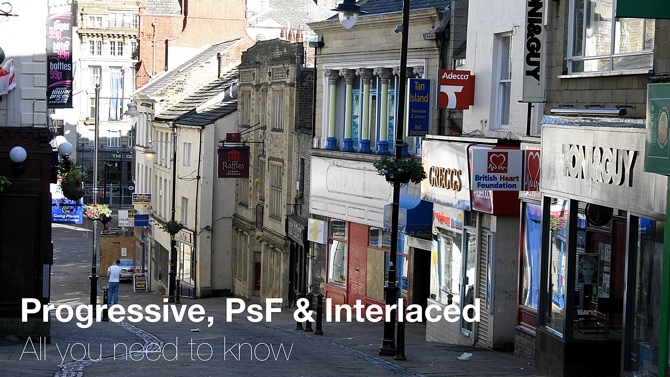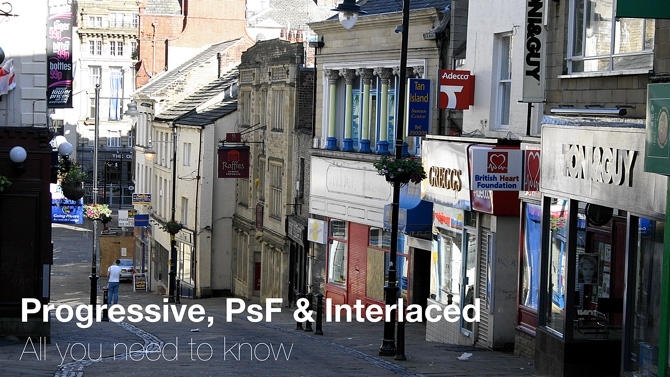
 Progressive, Interlaced, PSF. A street in Yorkshire
Progressive, Interlaced, PSF. A street in Yorkshire
If you or I were asked, given current technology, to create a system to record and display moving images, we probably wouldn’t build what actually exists right now. We'd do it completely differently, says Phil Rhodes.
This isn’t an unusual situation, since everything from the internet to the human body have aspects that, frankly, could be better built. Even so, I often sit in open-mouthed dismay at some of the more egregious historical issues that we suffer in the film and TV industry. Engineers who can’t count to thirty in whole numbers spring to mind, but at least the choice of 29.97fps for NTSC video was always recognised to be a problem solving measure.
Interlacing video
Interlacing, on the other hand, is unequivocally a deliberate engineering technique which made electronic television work better with the technology of the 1930s. The technique of breaking a picture up into lines and transmitting the brightness of each suggests the simple approach of capturing and then transmitting each line in order, then receiving them and scanning them all back out onto the display in the same sequence. The problem is that to achieve a reasonable amount of vertical resolution, we need several hundred lines – 405 in the earliest UK system. To achieve a reasonable amount of horizontal resolution, though, there’s a maximum speed you can send each line, especially with early twentieth century radio equipment. Taking 400-plus lines and delivering them fairly slowly inevitably results in a visible scanning action from the top to the bottom of the frame, somewhat akin to the rolling shutter effect found on some CMOS video sensors.
In 2012 we have easy access to electronics that are capable of storing the complete data for a frame until it’s all arrived, then displaying it simultaneously. Back in the day, though, the solution was to interleave alternate lines – capture and send all the odd lines and scan them out, then capture and send all the even lines and scan them out, in between the odd. This interlaced scan pattern makes two passes over the picture per frame, and these two images, each comprising half the lines of the frame, are called fields. In essence, we make it flicker more, or at least more frequently, in order to make it appear to flicker less.
Interlaced video hasn't gone away
The historical fallout of this is quite complex, especially as the majority of the world’s TV is still shot in interlaced formats. Film, of course, knows nothing of interlacing, since the whole frame is recorded and displayed more or less simultaneously. When material shot on film is transmitted on TV, special techniques are used. Most straightforwardly, where 24fps film is show on PAL TV, we simply speed up the frame rate and take both fields from the same film frame. Because both of the fields were photographed at the same point in time, the way in which motion is captured is visibly different, and this is responsible for a large part of the different appearance of film-originated material when it’s viewed as video.
The reasons behind people’s desire to make video look like film are numerous and well-known, but when that started to become a common goal, replicating the different motion rendering became important. The most straightforward approach was to simply discard interlaced scan, capture all of the lines simultaneously, then to display them all at once. This is referred to as progressive scan, and it’s the most obvious approach, although it does require a ground-up reworking of most of the camera and recording equipment.
Expressing progressive as interlaced
But hang on; wasn’t there already a way of transporting progressively-scanned film images as video? The PAL world had traditionally viewed films at 25 frames per second, simply by recording both interlaced fields from the same film frame, and that technique works perfectly well as an approach to persuade traditional interlaced-scan video equipment to work with progressive pictures even if those pictures weren’t captured on film. This isn’t to say that you can simply stick any progressive image into any interlaced system; sometimes, progressive material shown as PAL video was filtered to remove sharp vertical details, to minimise the visible differences between lines, and therefore minimise visible flicker. The technique used to display film-originated material on a PAL display, and the technique used to transport progressive frames over an interlaced video system, aren’t always precisely identical. Still, they are broadly comparable, and this is a simple, practical technique, probably most popularised by Sony, who referred to it as progressive segmented frame, notated PsF.
It's easier than it seems
So, to sum up: if you want to transport progressive material over an interlaced system, simply scan or ingest it as if it were interlaced. The fact that each of the two interlaced fields were captured (by a camera sensor) at the same time means that when the two fields are viewed in sequence, there will be no motion in the original material between them. So they will still look progressive.
All three of these formats – interlaced, progressive, and progressive segmented frame – exist as tape and file formats and as signals on SDI cables. In an ideal world, these are things that will be handled automatically, and if your professional life involves shooting files to flash cards it’s unlikely to ever become a problem. You could even argue that in a modern world of file-based formats, PsF is becoming increasinly irrelevant, but that’s far from universally the case as formats take a while to drift fully into legacy status.
As I say, if we designed the film and TV production ecosystem right now, we probably wouldn’t succumb to these complexities, but unfortunately that’s not the case. Anyway, if this article helps anyone solve a complex problem, perhaps with older material or using an unfamiliar piece of video tape equipment, then it’ll have done its job.
Tags: Technology


Comments